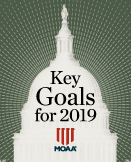
MOAA's top legislative goals for 2019 will be featured in an upcoming edition of Military Officer magazine, which is available to MOAA Life and Premium members. Here's a preview of one key issue; see the links below for the rest, including ways you can make your voice heard.
The Goal: Sustain military pay comparability with the private sector.
Background: A residual 2.6-percent pay-raise gap still exists between servicemembers and private-sector civilians, attributable to three years of pay-raise caps. Political pressure to reduce costs might lead Congress to again cap military pay raises, widening the pay-raise gap between military and civilians.
MOAA's Stance: As the cost of labor increases across the nation, so too should the paychecks of our uniformed servicemembers. Adequate pay and allowances - including competitive raises - are key to recruiting and retaining an effective all-volunteer force. This issue affects all currently serving uniformed personnel and their families, and succeeding on this issue has a positive, far-reaching impact. Any pay raise set by the FY2020 National Defense Authorization Act (NDAA) must match the Employment Cost Index (ECI) increase of 3.1 percent -- anything lower will make the pay gap wider.
Actions: Maintain continuous, unified messaging to legislators and service leadership, advising annual military pay raises approved by Congress correlate with ECI to help overcome damage done by the three recent pay caps (2014-2016). Coordinate with The Military Coalition to address this wide-reaching imperative of support to those in uniform, and seek closure of the 2.6-percent gap as soon as feasible.
[TAKE ACTION: Military Pay and Benefits Matter]
More key goals:
- Ensure any TRICARE reform sustains access to top-quality care.
- Prevent disproportional TRICARE fee increases
- Stop erosion of compensation and non-pay quality-of-life benefits.
- End financial penalties for military survivors.
- End concurrent receipt penalties for military retirees.
- Achieve equity of benefits for Guard and Reserve members with their active duty counterparts.
- Strengthen DoD-VA collaboration and services to support wounded warriors and an expanding population of women veterans.
- Ensure timely access to service-earned VA benefits.
- Protect military and veteran family support programs and policies.
